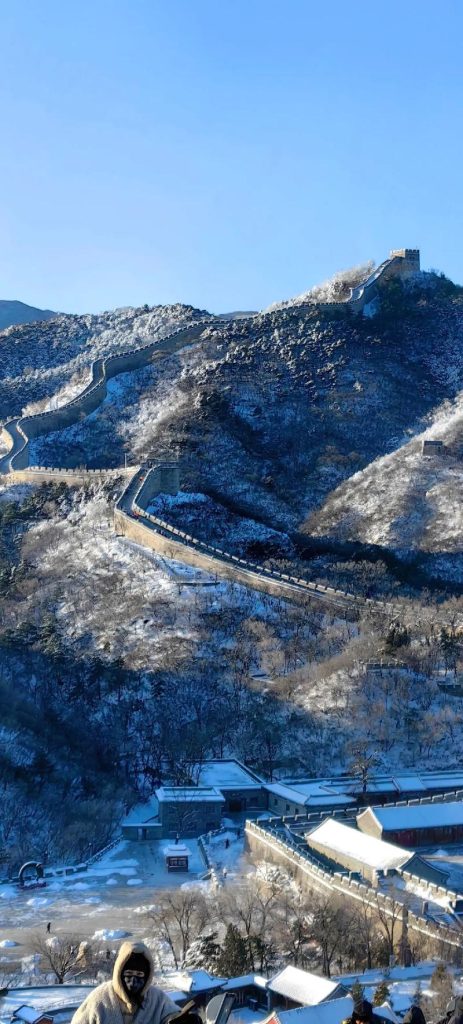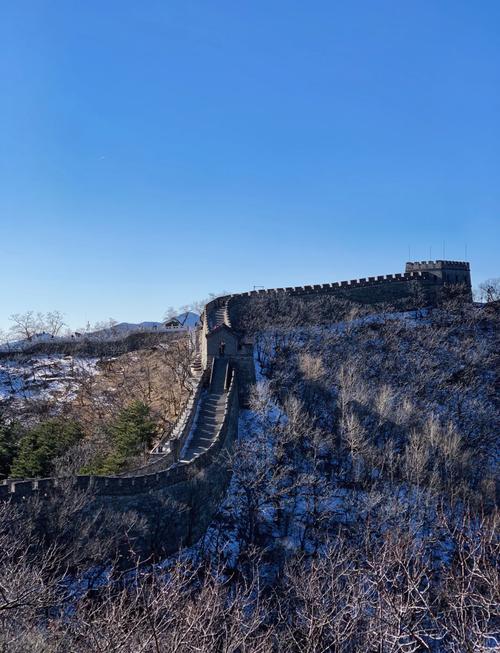A Winter Wonderland Experience
December is a magical time to visit the Great Wall of China. It’s when the bustling crowds fade, and the ancient stone walls are wrapped in winter’s quiet charm—sometimes even dusted with snow.
This month isn’t for everyone, but for travelers who love peace and unique scenery, it’s a hidden gem. The cold air brings crisp skies, and the winter light makes the Great Wall’s bricks glow softly.
First, let’s talk about the weather. December temperatures along the Great Wall drop sharply, ranging from -8°C to 5°C (18°F to 41°F) during the day. Nights can plummet to -15°C (5°F), especially in mountainous areas like Jinshanling.

Snow is common in late December. Light flurries turn the Great Wall into a white wonderland, with snow covering the steps and weighing down the branches of nearby pines. It’s a sight you won’t see in warmer months.
But be ready for wind. December winds sweep across the open mountain ridges, making the cold feel sharper. A thick windbreaker and a warm scarf are non-negotiable.
One of the best things about December is the lack of crowds. October’s holiday rush is long gone, and most tourists avoid the cold. This means you’ll have stretches of the wall to yourself.
Imagine standing on a watchtower, with no one else around. The only sounds are the wind and the crunch of snow under your boots. It’s easy to feel like you’ve stepped back in time, away from the noise of modern life.
Photographers love December. Snow contrasts beautifully with the Great Wall’s gray bricks, and the clear winter sky makes every shot vibrant. Sunrise and sunset are especially stunning—pink and orange hues paint the snow-covered mountains.

Different Great Wall sections have unique December charms. Let’s start with Mutianyu. Its well-maintained paths and cable car make it easy to visit even in snow. The cable car ride up offers bird’s-eye views of the snow-dusted wall.
Badaling, the most famous section, is quieter in December too. While it’s still visited, you won’t have to push through crowds. The nearby Badaling Ski Resort even lets you combine Great Wall visits with skiing.
When Is the Best Time to Visit the Great Wall of China?
For adventure seekers, Simatai is a great choice. Its wild, unrenovated walls look dramatic under snow. Just be careful—snow makes the stone steps slippery, so sturdy boots with good grip are a must.
What to wear? Dressing in layers is key. Start with a thermal base layer, add a thick sweater or fleece, and top it with a windproof, waterproof jacket. Don’t forget warm gloves, a beanie, and thick socks. Thermal boots will keep your feet dry and toasty.
Bring hot drinks too. A thermos of hot tea or coffee will warm you up during breaks. Most food stalls at the Great Wall are closed in December, so pack snacks like energy bars or nuts.
Check cable car and visitor center hours before you go. Many facilities shorten their hours in winter, closing by 4 PM instead of 5 PM. Plan to start your visit early to make the most of the daylight.
December also has a festive touch. Near Christmas, some Great Wall sections (like Mutianyu) decorate with small lights, adding a cozy feel to the winter evenings. It’s a unique blend of ancient history and holiday cheer.
Is December the easiest time to visit? No. The cold and snow require more preparation. But is it worth it? Absolutely.
Visiting the Great Wall in December lets you experience its grandeur in a new way. It’s quiet, beautiful, and full of winter magic. Whether you’re hiking alone or with a small group, you’ll leave with memories that last a lifetime.
So grab your warmest clothes, pack a thermos, and head to the Great Wall this December. It’s a winter adventure you won’t regret.